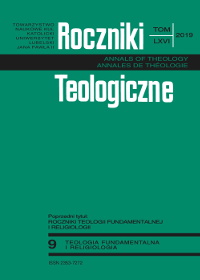National Civil Religion in the German Empire (1871-1918)
Abstract
The article draws on the argument presented by Carolyn Marvin and David Ingle (1996), and specifically on the thesis that nationalism can be also approached as a religious phenomenon- with its distinctive mythology, dogmas, “saints,” and ritual behavior; they term such ideological-ritual complex “national civil religion.” Using this heuristic tool, I analyze the quasi-religious content of German national ideology dominant in the Kaiserreich (1871-1918) by discussing three layers of imagery that can be distinguished in this ideological system: appropriated history as vell as Christian-Biblical and mythological-folkloric components.
References
Anderson, Benedict. (1991). Imagined Communities: Reflections on the Origin and Spread of Nationalism. New York: Verso.
Banac, Ivo. (1984). The National Question in Yugoslavia: Origin, History, and Politics. Ithaca: Cornell UP.
Barth, Rüdiger. (2011). “Supermacht Preussen. Teil 4: Aufstieg und Untergang”. Stern 49: 102-116.
Bleibtreu, Carl. (2010). Schlacht von Sedan am 1. September 1870. Langensalza: Verlag Rockstuhl [1910].
Bömelburg, Helen. “Supermacht Preussen. Teil 2: Der Weg in die Moderne”. Stern 47: 108-122.
Bourdieu, Pierre. (1991). Language and Symbolic Power. Cambridge, MA: Harvard UP.
Demandt, Philipp (2003). Luisenkult: Die Unsterblichkeit der Königin von Preußen. Köln: Böhlau.
Drewes, Patricia. (1999). “Königin Luise von Preußen: Geschichte im Spiegel des Mythos”. Pp. 157-178. In: An der Schwelle zur Moderne: Deutschland um 1800. Ed. P. Brandt. Bonn: Friedrich Ebert Stiftung.
Eley, Geoff. (1991). Reshaping the German Right: Radical Nationalism and Political Change after Bismarck Arbor. Ann: The University of Michigan Press.
Fesser, Gerd. (2012). Preußische Mythen: Ereignisse und Gestalten aus der Zeit der Stein/Hardenbergschen Reformen und der Befreiungskriege. Bremen: Donat Verlag.
Görden, Michael, ed. (1993). Das Buch vom wilden Mann: Der uralte Mythos neu betrachtet. München: Heyne Verlag.
Hroch, Miroslav. (2000). Social Preconditions of the National Revival in Europe. New York: Columbia UP.
Landes, Joan B. (2001). Visualizing the Nation: Gender Representation and Revolution in Eighteenth-Century France. Ithaca: Cornell UP.
Lorenzen, Jan N. (2006). Die großen Schlachten: Mythen, Menschen, Schicksale. Frankfurt am Main: Campus-Verlag.
Marvin, Carolyn and Ingle, David. W. (1996). “Blood Sacrifice and the Nation: Revisiting Civil Religion”. Journal of the American Academy of Religion. 64/4: 767-780.
Müller, Thomas, ed. (2006). Erlebnisse eines Thüringers im Krieg gegen Frankreich 1870/71. Bad Langensalza: Rockstuhl.
The New Jerusalem Bible. (1985). Ed. by Henry Wansbrough. New York: Doubleday.
Piwowarczyk, Darius J. (2013). “`Dialogue' with Political Opportunities: Creating Myths of National Origin in the Kaiserreich.” Jahrbuch der Philosophisch-Theologischen Hochschule SVD Sankt Augustin 1: 94-108.
Schieder, Theodor. (1992). Das deutsche Kaisereich von 1871 als Nationalstaat. Göttingen: Vandenhoeck und Ruprecht.
Schorn-Schütte, Luise. (2003). Königin Luise: Leben und Legende. München: C.H. Beck.
Smith, Helmut. W. (1995). German Nationalism and Religious Conflict: Culture, Ideology, Politics, 1870-1914. Princeton: Princeton UP.
Stürmer, Michael. (2000). The German Empire, 1870-1918. New York: The Modern Library.
Thiemer-Sachse, Ursula. (2009). “Hombre bárbaro versus hombre silvestre en la Nueva España: Ideas exóticas de origen europeo?” Anthropos 104/1: 81-92.
Treitschke von, Heinrich. (1897). Zehn Jahre deutscher Kämpfe. Teil 2: Von 1870-1879. Berlin: Reimer.
Weber, Max. (1988). “Parlament und Regierung in neugeordneten Deutschland. In: Gesammelte politische Schriften. Ed. Johannes Winkelmann (306-443). Tübingen: Mohr-Siebeck.
Weißmann, Karlheinz. (2007). Deutsche Zeichen: Symbole des Reiches – Symbole der Nation. Schnellroda: Edition Antaios.
Yamamoto, Dorothy (2000). Boundaries of the Human in Medieval English Literature. Oxford: Oxford UP.
Copyright (c) 2019 Roczniki Teologiczne

This work is licensed under a Creative Commons Attribution-NonCommercial-NoDerivatives 4.0 International License.





